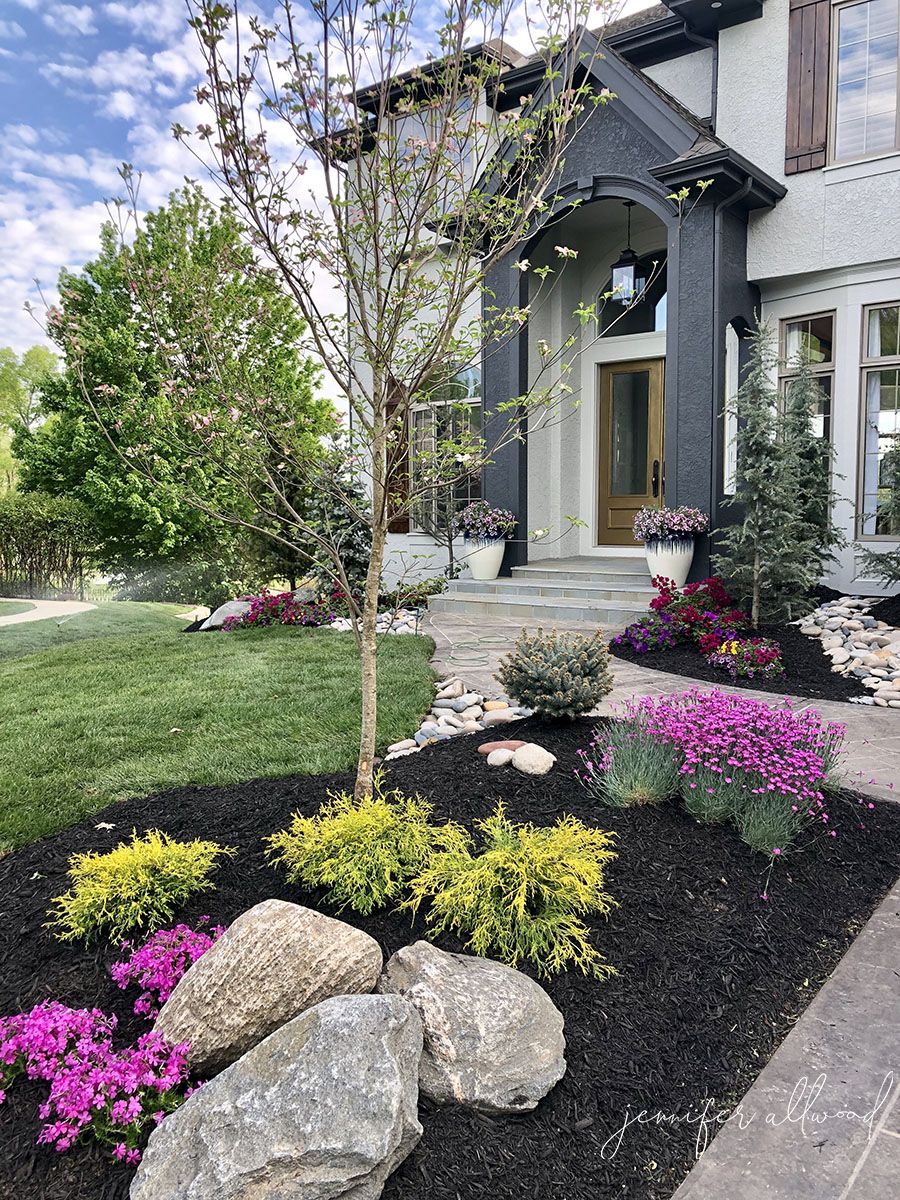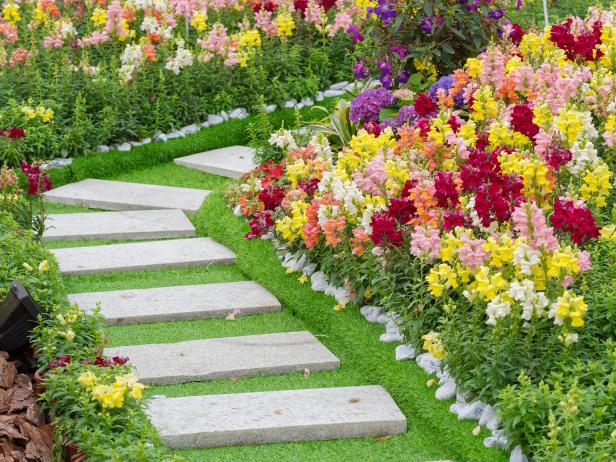Exploring Different Sorts Of Landscaping to Enhance Your Outdoor Environment
Landscape design plays an important role in specifying exterior rooms. Different designs, from traditional yards to modern-day minimalist styles, supply unique advantages for improving appearances and function. Incorporating elements like xeriscaping and native plants can add to environmental equilibrium. Recognizing the interaction of hardscape and softscape is crucial for developing inviting atmospheres. The choices offered can be frustrating, prompting one to review which design ideal aligns with their vision for an outside sanctuary.
Traditional Garden Landscape Design

While many modern-day gardens embrace minimalism and native plantings, typical garden landscape design continues to be a treasured method that highlights balance, framework, and decorative functions. This style frequently incorporates official geometric formats, where pathways, flowerbeds, and bushes are set up with accuracy. Central centerpieces, such as water fountains or sculptures, draw the eye and give a sense of harmony.Traditional landscaping regularly includes a range of plant types, showcasing seasonal blooms and evergreen components. Traditional bushes, perennials, and annuals produce vivid shades and appearances throughout the year. Furthermore, trellises, arcs, and pergolas include vertical rate of interest and act as support for climbing up plants, enhancing the general aesthetic.The usage of natural materials, such as stone and timber, more improves the typical landscape, contributing to an ageless high quality. Eventually, this design invites leisure and enjoyment, making it a cherished choice for those seeking a picturesque outside setting.
Modern Minimalist Landscaping
Modern minimal landscaping stresses simplicity and performance, defined by open areas and tidy lines. Key attributes include a restricted plant scheme and thoughtful hardscape design that focuses on use and visual allure. Efficient plant choice strategies further boost the minimalist method, developing peaceful outside settings that urge leisure and reflection.
Secret Attributes of Minimalism
A growing trend in landscape design is the accept of minimalism, identified by simplicity and functionality. Minimalist landscaping focuses on tidy lines, open spaces, and a restricted shade palette, advertising a feeling of peace. Components are meticulously curated to prevent clutter, permitting each part to stick out. Using all-natural products, such as rock and timber, improves the natural feel while keeping an aesthetic balance. Additionally, minimalist designs commonly include geometric shapes, which can produce visual interest without overwhelming the detects. Water features might be included, acting as focal points that enhance serenity. In general, minimalism in landscape design stresses the appeal of restraint, enabling nature's intrinsic qualities to beam through in an unified outside environment.
Plant Choice Strategies
Efficient plant option is necessary for attaining the preferred visual in modern minimal landscaping. The focus needs to get on simplicity, using a limited scheme of plants that match each other and the surrounding setting. Indigenous plants are frequently suitable, as they need much less upkeep and water, advertising sustainability. Choosing types with varying structures and elevations can add aesthetic interest without overwhelming the area. Organizing plants in clusters instead of spreading them improves cohesion and enhances the minimalist style. Evergreen selections can give year-round structure, while seasonal flowers present refined shade adjustments. Inevitably, the goal is to develop a serene outdoor area that symbolizes tranquility and harmony through thoughtful plant selections.
Hardscape Design Concepts
Necessary aspects in hardscape design substantially add to the total looks and capability of minimal landscaping. This design strategy stresses tidy lines and underrated products, developing a clean aesthetic experience. Secret elements consist of pathways, patios, and keeping wall surfaces, which not just define rooms yet likewise improve accessibility and usability. Making use of products such as concrete, rock, and timber is widespread, reflecting an all-natural yet modern visual. Integrating geometric forms and balanced formats even more reinforces the minimal ideology, allowing for an unified mix with bordering greenery. Additionally, proper drainage and erosion control are vital considerations, making sure long life and sustainability. Eventually, effective hardscape layout works as a foundation that complements softscape aspects while preserving balance and simplicity in exterior environments.
Cottage-Style Landscaping
Cottage-style landscaping supplies a wonderful method to producing inviting exterior rooms. By incorporating captivating plant mixes, this design cultivates a sense of warmth and fancifulness. The focus on relaxing, well-defined locations motivates leisure and pleasure of nature.
Enchanting Plant Mixes
Lots of home owners look for to create an attractive outdoor room, attaining the charm of cottage-style landscape design commonly hinges on thoughtful plant combinations. Lively flowers, rich vegetation, and aromatic natural herbs can be skillfully coupled to stimulate a feeling of fancifulness and nostalgia. For example, integrating lavender, daisies, and foxgloves creates a vivid tapestry that draws in pollinators while offering a wonderful scent. Integrating ornamental yards like miscanthus can include structure and motion, matching the softer blossoms. In addition, mixing perennial and yearly plants warranties continuous shade throughout the seasons. Using mountain climbers, such as clematis or honeysuckle, can improve vertical passion. In general, these mixes not just beautify the landscape but also promote a charming and welcoming ambience.
:strip_icc()/deck-and-grass-path-to-seating-8c4cf821-e4219e0bf29949978f786219b05f3ce1.jpg)
Relaxing Exterior Rooms
Developing comfortable exterior spaces calls for a mindful mix of comfort and beauty, complementing the lively plant combinations found in cottage-style landscaping - Landscape Lighting Installer. These locations often feature welcoming seating setups, such as weather-beaten wooden benches or cushioned chairs surrounded by rich plant. Soft illumination, like fairy lights or lights, adds warmth, changing the space right into a tranquil resort. Integrating elements such as trellises adorned with climbing roses or fragrant herbs boosts sensory experiences. Furthermore, pathways made from rustic stones invite exploration and connection with nature. Attractive touches like birdbaths or wayward garden art contribute to a sense of fancifulness. Eventually, the objective is to produce an enchanting ambience that encourages leisure and pleasure of the beauty surrounding these comfy outside places
Xeriscaping for Water Preservation
How can neighborhoods stabilize visual landscaping with journalism requirement for water preservation? Xeriscaping becomes a practical solution, promoting sustainable practices that minimize water usage while enhancing outside appeal. This landscaping technique concentrates on making use of drought-resistant plants indigenous to the region, which require considerably much less water than conventional yards. By integrating compost and effective watering systems, xeriscaping decreases dissipation and overflow, more saving priceless water resources.Communities can create visually enticing landscapes through careful preparation, selecting a diverse variety of structures and shades that grow in dry conditions. In addition, xeriscaping urges go to the website making use of decorative rocks and decorative gravel, offering useful and eye-catching options to grass lawns. As neighborhoods accept this environmentally friendly strategy, they not only decrease their water consumption but also advertise biodiversity and resilience in their neighborhood communities. Eventually, xeriscaping functions as a demo of the harmony in between visual appeal and environmental responsibility.
Hardscape Design Aspects
Hardscape style aspects play a necessary duty in enhancing outdoor spaces by providing framework and capability. These non-plant functions, such as patio areas, decks, walkways, and wall surfaces, create aesthetic passion while offering sensible objectives. Using products like concrete, rock, and block, hardscaping contributes to the overall aesthetic charm and sturdiness of a landscape.Incorporating hardscape components can specify areas within a backyard, directing activity and encouraging social interaction. A well-placed path can link various areas of the yard, while keeping wall surfaces can take care of altitude modifications and avoid erosion.Furthermore, hardscape layout can boost access and security, giving steady surface areas for lounging or strolling. Reliable integration of hardscape parts enhances soft landscape design, ensuring a balanced exterior setting. Eventually, thoughtful hardscape layout boosts not just the beauty of outside areas but likewise their functionality, making them extra inviting and functional for site visitors and home owners alike.
Exterior Living Rooms
While outside living areas supply a seamless mix of comfort and nature, they work as crucial extensions of a home, boosting way of living and leisure. These areas can consist of patio areas, decks, or outside kitchen areas, created to cultivate leisure and entertainment. Bbq Island Installation. By including useful furnishings and stylish decor, house owners develop welcoming ambiences for celebrations or quiet evenings.The integration of shade structures, such as awnings or pergolas, safeguards versus the elements while maintaining an open feel. Fire pits and exterior heating units expand usability right into cooler months, supplying warmth and ambiance. Furthermore, incorporating lights attributes improves the area's usability after sunset, producing a magical evening atmosphere.Landscaping aspects, such as pathways and borders, even more define these locations, assisting motion and adding aesthetic allure. Eventually, exterior space transform yards into versatile retreats, promoting a way of living that accepts both nature and comfort
Native Plant Landscaping
Indigenous plant landscaping stresses the usage of aboriginal plants to create harmonious and lasting outside atmospheres. This approach not only enhances biodiversity however likewise conserves water and lowers the requirement for chemical fertilizers and pesticides. By picking plants that are belonging to a details area, property owners can guarantee that their landscapes are well-adapted to regional soil and environment problems, resulting in lower maintenance requirements.Additionally, indigenous plants supply important habitats for neighborhood wildlife, consisting of birds, butterflies, and bees, promoting environmental wellness. Landscape designs that include these plants typically include naturalistic layouts that imitate local ecological communities, promoting a local color and link to the environment.Furthermore, native plant landscape design can add to soil security and disintegration control, making it an environmentally liable choice. On the whole, this method not just enhances exterior rooms but additionally supports the local ecosystem, developing a sustainable equilibrium between human task and nature.

Regularly Asked Questions
How Can I Select the Right Landscaping Style for My Home?
Choosing the right landscape design design for a home includes assessing the residential property's architecture, environment, and personal preferences. Bbq Island Installation. Looking into various designs and speaking with specialists can offer advice to produce an unified outdoor area tailored to individual needs
What Is the Typical Price of Expert Landscaping Providers?
The average price of specialist landscape design solutions generally varies from $1,000 to $5,000, depending upon task area, dimension, and complexity. House owners should think about obtaining multiple quotes to assure they obtain fair rates and top quality solution.
Just how Typically Should I Preserve My Landscaped Yard?
The frequency of keeping a landscaped yard typically depends upon the plants and attributes existing. Usually, routine maintenance every couple of weeks is encouraged, with seasonal tasks increasing in frequency throughout peak expanding periods for suitable wellness and aesthetics.
Exist Landscaping Options for Little Urban Spaces?

Numerous landscaping options exist for little metropolitan rooms, including upright gardens, container plants, and roof gardens. Including these components can make best use of minimal locations while my review here providing greenery, improving aesthetics, and boosting air high quality in city settings.
What Plants Are Finest for Drawing In Neighborhood Wild Animals?
The best plants for attracting local wildlife include indigenous blooming types, berry-producing hedges, and hop over to these guys varied turfs. These plants supply important food and habitat, fostering a growing community that sustains different birds, insects, and tiny mammals. Lots of house owners look for to develop a picturesque outside space, achieving the charm of cottage-style landscape design commonly hinges on thoughtful plant mixes. Producing comfortable outdoor spaces calls for a mindful blend of comfort and charm, enhancing the dynamic plant mixes found in cottage-style landscaping. Native plant landscaping emphasizes the use of aboriginal flora to create harmonious and sustainable outdoor environments. Landscape creates that incorporate these plants commonly include naturalistic formats that mimic local environments, fostering a sense of area and link to the environment.Furthermore, native plant landscaping can add to dirt security and erosion control, making it an ecologically accountable choice. Different landscape design choices exist for little metropolitan spaces, consisting of upright yards, container plants, and roof gardens.